This is the multi-page printable view of this section.
Click here to print.
Return to the regular view of this page.
Sciebo Documentation

Welcome to the advanced
Sciebo-Documentation!
Here you can find Explanations for basic functionality and also some tips and tricks for more advanced users.
Basic functionality is also explained
on our homepage.
HELP! Everything looks different now!
Your instance has probably been migrated.
Please find more information here: Nextcloud-Migration
1 - FAQs
Frequently asked questions
Questions about accounts
My account name has changed. What do I have to do?
If your account name has changed (e.g. because you have moved to another university and have received a new ID), you must register again. Unfortunately, you cannot continue to use your old account. If necessary, you can manually move your data from the old to the new account.
My name has changed. What do I have to do?
As long as your ID has not changed, you only need to renew your sciebo account in
my.sciebo to update your data.
My e-mail address has changed. What do I have to do?
As long as your ID has not changed, you only need to renew your sciebo account in
my.sciebo to update your data.
I left the university and cannot access my account anymore. What can I do?
Once you have left your institution, you cannot extend your sciebo account
anymore. Your account will be locked after a grace period of a year after the
last extension and afterward deleted.
If you have forgotten to back up your files, you can open a
support ticket.
I am a student and need more than 30 GB of storage. What can I do?
Unfortunately, students cannot increase their storage volume at the moment.
I am an employee and need more than 500 GB of storage. What can I do?
You can apply for a project box.
I am a guest and want to reset my password.
Please notify your sponsor; they can send you a password reset link via the
guest management in mysciebo.
Why do I have to extend my account once per year?
Once per year you have to confirm that you are still eligble to use sciebo.
The grant conditions of the state of NRW require that only students and
employees of participating institutes may use sciebo.
Having users confirm their eligibility once per year affords us to offer a
grace period, whereas other approaches where we get the confirmation
automatically from the institutes would mean that you lose access to sciebo
the second you are not member of the institute anymore.
Access to files
Can I access my sciebo account via SMB/FTP/SSH?
No, the protocols mentioned are not supported. You can use sciebo via the web interface, the desktop client or the apps.
Can I access my sciebo account via WebDAV?
In general, it is possible to use sciebo via WebDAV. We explicitly advise against using
sciebo as a Networkdrive or mounting it via webdavfs, as this reliably leads
to data loss. Other webDAV clients might work just fine, but we can not offer
any support for those. Best to use sciebo via the web interface, the desktop
client or the apps.
I have left the university and can no longer access my account. What can I do?
If you leave your institution, you can no longer renew your sciebo account, and it will be blocked after a grace period (of max. 1 year from the last renewal) and subsequently deleted. If you forgot to back up your data before the blocking, open a
support ticket.
I have a server on which I cannot install the client, but I want to exchange files via sciebo?
rclone can be run well on several headless platforms.
Please note that rclone is not as smart as the sciebo client when it comes to
discovering changes, so please use it to sync as infrequently as you can
afford on larger datasets or explicitly check for changes of small subsets of
your data.
Data has disappeared from my account. What can I do?
There may be various reasons why data can no longer be found. First check the following solutions:
- If you have deleted data by mistake, you can restore it within 7 days (depending on the available storage space also considerably longer), provided you are the owner of the data. To do this, log in to the web interface and select the recycle bin in the left menu bar. You can restore the data listed there directly.
- If data that was shared with you is missing, contact the person who shared the data. They may be able to restore the share or data (if it was accidentally deleted). Also note that data shared by a user will no longer be available if his or her sciebo account is deleted.
If your data could not be restored in this way, open a
support ticket. Please also remember to make regular backups of your data.
Questions about the clients
Why am I unable to select or deselect folders for synchronizing on the desktop client?
If - despite the client being connected - there are no options for selecting
or deselecting folders, it is usually because your client uses the Virtual
File System (VFS). There only metadata is being synchronized to your system
and files are being downloaded on demand, so only very little disk space is
used.
What is Virtual File System (VFS) and what do I need to be aware of?
The VFS is a Feature which can be used on Windows or Mac to use only very
little diskspace. Files are only downloaded on demand and reflected by
placeholder files.
However, on the downside you can not make backups from your sciebo files this
way, so this is mainly an option for workstations shared by multiple users.
I am getting an error “Access Forbidden State token Missing” (iOS Nextcloud App)
- Loggin in through the browser.
- Go to Personal Settings → Security.
- Removed the iOS device from the list.
- At the bottom of the page, write an app name (e.g., iPhone) in the field and click “Create new app password”.
- Then, use the QR code method to connect the App to the server.
Questions about Overleaf
How can I share in overleaf?
The webinterface lies: overleaf does not send e-mails.
You can only share with people who have logged into the sciebo overleaf at
least once and created a project.
Then you can share with their regular sciebo ID they use at their sciebo
instance; you do not need to use the federated ID (the one with the double @).
Can we enable additional features like zotero integration or GitHub in overleaf?
We currently use a (somewhat dated) version of the open source version of
overleaf, which can be found at GitHub and are unable to provide additional
features.
The current featureset is somewhere between their proprietary free and basic
tier.
Why is Overleaf not sending emails? Can I import or export data to and from sciebo?
Also, sending emails to other (especially external) users is not possible. To share a project, the receiver has to log in at least once into Overleaf and create a project.
Can I import or export data from overleaf to sciebo or vice versa?
Sadly no.
The current installation is only partially integrated in sciebo.
It is therefore currently not possible to im- or export data from sciebo directly.
It is possible however, to export and import projects as .zip-files.
Can additional features like the Zotero or Github-integration be activated in Overleaf?
Since we use the open source version of Overleaf from GitHub as it is, it is currently not possible to add additional features.
Questions about the web interface
Can I include members from other instances to custom groups?
Unfortunately, this is currently not possible.
Where have the (custom)groups gone?
Probably your sciebo instance has been migrated to
Nextcloud.
Groups can now be found under Contacts/Teams.
I am asked about a second factor despite not having one set up
This is sadly a known bug during the
Nextcloud migration.
Please open a
support ticket
with your university e-mail adress.
Miscellaneous
How can I receive large files from externals?
If you only need to receive a couple of files once, but which are too large
for email attachments, you can use a public link filedrop.
For this log into the webinterface and create a folder in which you want to
receive the file(s) and then click the share button; there you select the tab
“public links” and then you create a link with password, expiry date and
upload rights.
Please do not use the built-in mail function, but just create the link.
Once the link is created, you can copy it to your clipboard from the right
side menu in the webinterface and then send it, together with the password, to
the person(s) you want to receive files from.
Why do I need to make a backup? I sciebo not safe?
Making backups is just part of good data hygiene.
Sciebo is a collaborative workspace and not a backup vault.
Several scenarios can lead to data loss:
- People you have shared with deleting your data by accident
- Mounting sciebo as a Network drive and Windows doing weird things
- You losing access to your sciebo account because you have missed the
extension E-mail or change institutions
Why are you using OnlyOffice and not Microsoft Office 365?
OnlyOffice is open source and is hosted on our own servers. This mode of
operation is impossible with Microsoft Office. Thus both data souvereignity
and security considerations exclude the operation of Microsoft Office 365.
Furthermore does Micrsofot Office work not as reliable on the scale of sciebo.
For open document formats we also offer Collabora on those instances, which
already have been migrated to Nextcloud.
2 - Current Outages
Current and past outages.
Current outages
Please refer to our German outage document.
In case of outages we usually lack the time to update two languages.
3 - Download
Information about downloads

The desktop client is a program that allows you to store your data from the cloud locally on your computer or laptop. The client runs in the background and automatically synchronises your data so that you always have the latest version of a file available on all devices.
The app for mobile devices is ideal for viewing and sharing files on the go. You can upload, delete and move files (such as photos). However, because mobile devices usually have limited storage space, your files are not automatically downloaded. A file is not saved on your device until you manually access it.
Please note that we are currently migrating from ownCloud to Nextcloud. Therefore, this section contains clients for both ownCloud and Nextcloud. If you are not sure which client to install, please refer to the list of migrated instances. Further information on migrating to Nextcloud can be found here.
Nextcloud Clients
Desktop
Before installing the new client, the old client needs to be uninstalled.
Alternatively, you can remove the synchronization and set it up anew.
Mobile
As long as not all sciebo instances have been migrated, iOS users can use the
unbranded Nextcloud client from the app store.
For Android, you can use the following APK:
Checksums
4 - Account
Information about your account

In
my.sciebo you can access information about your user account, change your password, extend the term of your account and delete your account. As a university employee, you can also increase your storage volume from 30 to 500 GB.
-
Open
my.sciebo. (You must authenticate with your institution to do this.)
-
Click on “Account Information”. There you can view the following information:
- ID
- User name
- E-mail address
- Storage volume
- Expiration date
Changing Your Password
- Open
my.sciebo. (You must authenticate with your institution to do this.)
- Click on “Change Password”.
- Enter your new password. It can contain upper and lower case letters, numbers and the following special characters: . : ; = ! # ( ) + , - _ /
- Confirm the password change.
Renewing Your Account
Your account is valid for 12 months from the date of renewal. As long as you are a member of your institution, you can renew your account at any time.
- Open
my.sciebo. (You must authenticate with your institution to do this.)
- Click on “Renew account”.
- Confirm the renewal.
Deleting Your Account
If you delete your account, your data stored in sciebo will be irrevocably removed from the sciebo servers. Locally stored data (i.e. data synchronised via the desktop client) will remain on your PC.
Please note that shares will also be deleted. This means that data you have shared with other users will no longer be available to them. If necessary, inform these users in good time so that they can make their own copies. You can view a list of all folders and files you have shared in the web interface.
- Open
my.sciebo. (You must authenticate with your institution to do this.)
- Click on “Delete account”.
- Tick the box “Confirm deletion”.
- Click on “Delete”.
- Your account will be deleted within the next 24 hours.
Increasing Your Storage Volume (Employees Only)
As an employee, you have the option of increasing your storage volume to 500 GB on your own.
- Open
my.sciebo. (You must authenticate with your institution to do this.)
- Click on “Increase volume”.
- Confirm the volume increase.
5 - Apps
Information about application that are compatible with sciebo.
5.1 - Connecting the *Cloud - FileLink with Thunderbird
Send really big files with the email client thunderbird through sciebo
If you use the Thunderbird email programme with the *cloud - FileLink extension, you can upload large email attachments to
Sciebo and then just send the download link.
Installation of the Thunderbird
Follow the
download link to download the suitable file
for your operating system, then run the file and follow the instructions for installation.
Installation of the *cloud- FileLink
- Go to
Thunderbird -> Settings -> Composition -> Attachments -> Find more providers...
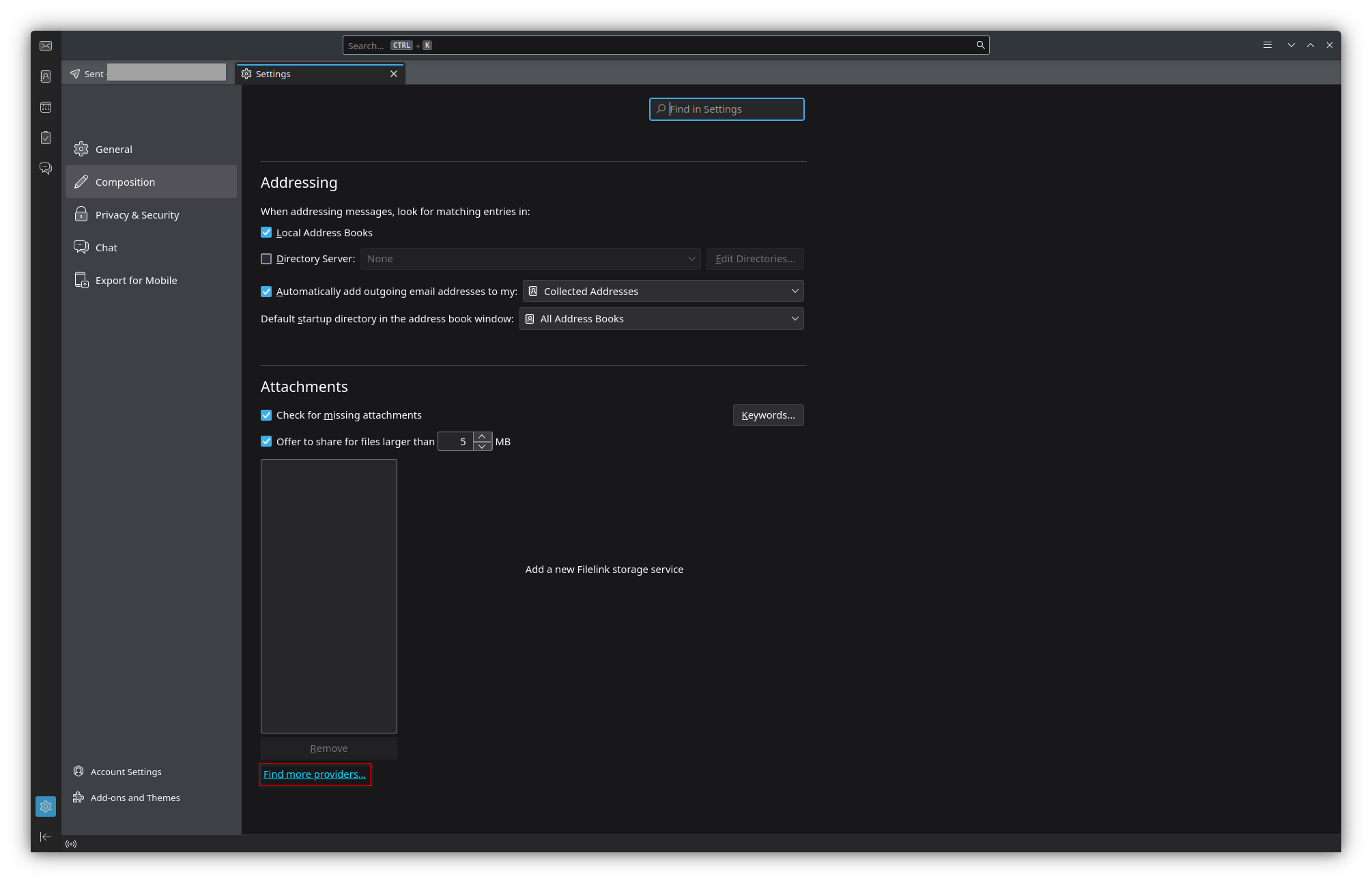
- A new tab would open, enter "*cloud “ in the search field.
- Click on “+ Add to Thunderbird. In the popup window click again on “add” and close the tab.

- Click on the newly appeared field
*Add *cloud in the Attachments section
- Fill the form:
- Server URL: the URL of your institution’s Sciebo instance (e.g.
https://sciebo.uni-muenster.de)
- Username: your Sciebo account
- App token or password: Your Sciebo password
- Click on
Save
Usage
When composing an e-mail, click on the drop-down menu next to " 📎Anhängen” and select Filelink -> *cloud.
Select the file you want to attach and click ‘Open’.
The selected file will now be uploaded to your Sciebo account and the recipient of your e-mail can download the file using the link.
5.2 - Fill file drop with scripts
Sometimes data is generated automatically somewhere and you want to move it to a specific Sciebo folder.
Preferably in an automated way.
In this case, you can share the folder via a link and create a share with
write permission (and password).
The link will look something like this:
https://uni-muenster.sciebo.de/s/XphYPtnTxc2MDm0 and the password could be secter. The part after the /s/ is the
username that you would use to interact with the webdav interface https://uni-muenster.sciebo.de/public.php/webdav/ and
the password is the corresponding password.
You can now send a request to the Sciebo webdav interface for example with Curl and upload a file data.csv via:
curl -u "XphYPtnTxc2MDm0:geheim" -T "daten.csv" https://uni-muenster.sciebo.de/public.php/webdav/daten.csv
Note that the webdav interface does not have an update verb (as far as we know), i.e. if you want to overwrite a file,
you must first delete the file using the following command:
curl -u "XphYPtnTxc2MDm0:geheim" -X DELETE https://uni-muenster.sciebo.de/public.php/webdav/daten.csv
5.3 - Joplin
Synch notes on your smartphone or ypur laptop through sciebo
The Joplin app allows you to create notes on your smartphone or desktop/notebook and synchronise them via sciebo.
You can download the apps at
https://joplinapp.org/.
To synchronize the Joplin using Sciebo go to Tools -> Options -> Synchronisation

- Synchronisation target: WebDAV
- WebURL: https://your-institute.sciebo.de/remote.php/dav/files/your-sciebo-ID/Joplin where is to be
replaced by the abbreviation used by your institution, to access Sciebo via a web interface. For example for University
of Münster it would be
uni-muenster.
- WebDAV username: your Sciebo id, for example for University of Münster it would be
username@uni-muenster.de
- WebDAV password: your Sciebo password
During synchronisation, a new folder Joplin will be created in your Sciebo folder. Your Joplin notes will be stored in this folder.
5.4 - Office Integrations
Office integration for sciebo
In sciebo wie currently offer two Office integrations:
- OnlyOffice for
.xlsx, .docx, .pptx
- Collabora for
.ods, .odt, .odp, .odg
With OnlyOffice we only have a limited number of licenses, so that in peak
hours (about 11am) it can occur that not everyone can use OnlyOffice.
In this case one can only wait and try again later.
Collabora is currently in testing stage and not limited by the number of
licenses.
Current issues with OnlyOffice and federated shares
Currently editing files which have been received via federated shares does not
reliably work in OnlyOffice. The devolopers are working on a solution.
5.5 - Overleaf
Our Overleaf app - hosted in germany and free for sciebo users
Sciebo offers an integration of the collaborative LaTeX tool overleaf.
This integration is based on the open source variant and its feature set is
roughly between the free and basic tier of the commercial overleaf service.
We run our own overleaf instance, which can be used by all sciebo users.
The integration currently requires considerable development effort on our side
and is provided as is.
In particular, we recommend to make regular backups of overleaf projects via
the download function of overleaf projects, as we have only limited ability to
restore singular projects.
Sharing
In order to be able to share with a person, it first has to log into our
overleaf instance via sciebo and create a new project.[^1]
If you receive a share, there is a notification in the project overview about
this.
This invitation can be accepted via “Join project” or be dismissed by a click
onto the cross.

Note that for sharing with persons from other universities, you do not need to
use the federated id, but just their local username, which is everything
before the second “@”. This feature can be used for guests at
https://gast.sciebo.de also.
Import and export of projects
Currently, it is sadly impossible to directly interact with the sciebo storage,
but it is possible to use .zip archives both for importing and exporting
projects.
To import a project, you click on “New Project” and use the upload option:
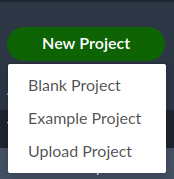
To export/download a project, you click on the small cloud symbol in the
project overview:

Known problems and non-features
- Overleaf does not send out e-mails; you have to inform share receivers by
yourself
- we run Overleaf in Version 3 and are evaluation forks for our update path to
Version 5. Until then we can not tell how the future feature set will look
like
- sharing only works after a person logged into overleaf via sciebo at least
once
- you cannot directly import from sciebo or export to sciebo
- we allow for compiles beyond one minute, but the webinterface has a bug
telling you after 60 seconds that it does not work. Subsequent clicks on the
compile button then should return a message that a compilation is already
running. If that is the case and only your initial compile takes longer than
60 seconds, you usually can still get a full compile sequent on subsequent
compiles.
- folder and filenames are heavily restricted; sadly if the folder name does
not match the rules, no error message is being thrown. If a name is not
allowed as a filename, it is also forbidden as a foldername
$( 1 )$: To be honest we are not completely sure if it is necessary to really
create a project beforehand. Logging in definitely is necessary though and
when there is a project, we can be sure that a login happened.
6 - Dangerous Mistakes
Avoid these mistakes at any cost!
Some things that one can do with sciebo will lead to the loss of data. This may not always be obvious.
Combining the sciebo-Client with Sync-Services
You cannot use the sciebo-client and another cloud-client, such as Google Drive, dropbox or Microsoft OneDrive for the same folder.
Especially folders synchronized to Microsoft OneDrive may be a little hard to recognize.
Combining a Sciebo-Client with another Sciebo-Client
You should not use the same folder with two different sciebo-clients. This may happen if for example a partition of your hard drive is used by two different operating systems.
Using the Sciebo-Client with a Network-Drive
The Sciebo client cannot be used with a Network-Drive. Errors in network traffic can quickly lead to the loss of data, and Errors in Network traffic occur more often than many people think.
Using WebDav to use sciebo as a Network-Drive
It would be nice if this worked well. But data is transferred only at specific times, that are hard to control (or even see) by the user, and so it may happen that sciebo does not receive the data at all or only empty files.x
7 - Good to know
Additional Information that could be interesting for you.
7.1 - Client Logs
You can find errors yourself!
Client Logs
If the client throws up errors, it is often helpful if you can send logs to the support team in which the client perhaps provides a little more information about what exactly went wrong.
By default, the client does not collect any logs. In newer desktop clients, you can configure the logs by pressing the F12 key; this menu also shows where the logs are located, and you can open the corresponding folder.
7.2 - Expiration and Deletion Dates
expiration ands deletion dates for your sciebo accounts
| Action |
Acoount-Type |
Date |
| account block |
regular |
last login date + 12 months |
| account deletion |
regular |
date of account block + 6 months |
| account block |
guest |
last login date + 12 months |
| account deletion |
guest |
date of account block + 30 days |
| account block |
project box |
last login date + 24 months |
| account deletion |
project box |
date of account block + 6 months |
7.3 - Known Bugs
Unfortunately, there are problems that we are aware of but cannot (immediately) fix.
Desktop client auto updater not working
The desktop client has an auto-updater which should ensure that the latest version is always installed. However, in some
cases this mechanism does not work, so that older version remain installed.
Currently (November 2024), version 5.3.1 should be distributed. If you still have an older version, you should update the
client manually by downloading and installing the new version from {< rawhtml >}www.sciebo.de{< /rawhtml >}.
Problems with updates of the desktop client under Linux
Sporadically, there may be problems with the client signatures. If ‘apt update’ says something about ‘invalid signature’,
it may be worth following the tips described in {< rawhtml >}this GitHub issue {< /rawhtml >}.
Linux desktop client no longer starts
If the desktop client displays the following error message
qt.qpa.plugin: Could not load the Qt platform plugin “xcb” in “” even though it was found. This application failed to start because no Qt platform plugin could be initialised. Reinstalling the application may fix this problem.
It is possible that the environment variable LD_LIBRARY_PATH=/usr/lib/x86_64-linux-gnu is set. In this case, it may be
helpful to change the environment variable to: env LD_LIBRARY_PATH="/opt/ownCloud/qt-5.15.2/lib/x86_64-linux-gnu/qt5/plugins/platforms" sciebo.
Sharing: An user cannot be found
This is only partially a bug and is therefore difficult to fix. There are several reasons why a person cannot be found
when sharing in sciebo:
- The person does not have a sciebo account
- The person has never logged into his sciebo account
- Instead of the sciebo account ID, the email address was entered (these do not have to be identical)
- The syntax ‘surname, first name’ does not work because the person has chosen in the settings not to be found using this syntax or has registered only one day ago
- You made a typo when entering the identifier, waited a moment, triggered the search and corrected the identifier while it was still running. Tip: Enter the identifier using copy&paste
7.4 - Permissions
Who id allowed to save what kind of data in sciebo?
We have not yet translated this page. For the german page, click here
7.5 - Who owns the data?
Generally we differentiate between two types of accounts:
Personal Accounts
The situation for personal accounts is obvious: The data is owned by the person that owns the account.
When a person shares a file with you from their personal account, you will have access to this file temporarily, but you do not own it.
If the person stops sharing their file with you or their account is deleted, access to the data is lost.
In this case we cannot recover your access to the file.
Project Boxes
In project boxes the institution or the registered project owns the data. If the person who created the project box stops working for the project or institution, their collegues can talk to the support and take over the project box.
Handling of business documents
Regulation of the handling of business documents is governend by the
participating institutes.
There can be made no distinction between the personal space in sciebo and
private storage devices.
For files which are not allowed to be saved on private devices, but should be
accessible in sciebo, project boxes can be used.
A good description and attribution to the working group in the project box
appliction can here help ease the support of certain issues in the future,
e.g. when people leave the institute.
8 - Guests
Sign up guests in sciebo - Collaborate also with external users

Projects often involve people who normally cannot use sciebo because they are not members of a participating institution. However, it is precisely here that a simple exchange of data is important. For this reason, there are guest IDs for these cases, which you as an employee can create yourself for your project partners.
Important: Guests must log in at
gast.sciebo.de, because they are not a member of an organisation that is part of sciebo!
The guest’s e-mail address used for the invitation serves as the guest identifier. The sciebo web interface can be accessed by guests via gast.sciebo.de. Desktop client and apps can be used by guests for synchronisation. Guest IDs are valid for 12 months, renewal is possible. To do this, the guest must contact their sponsor, who can carry out the renewal via my.sciebo. After expiry, the guest ID is blocked and deleted after a further 3 months.
Guests can only use sciebo in a limited way, i.e. they do not have their own storage volume and cannot actively share data. To collaborate with guests, sciebo users must first share files and/or folders with them and give them the desired editing rights. Guests cannot create files or folders in their home directory, but only in folders shared with them. In this way, guests use the storage volume of the sciebo users who share with them.
Inviting Guests
Please note that it is not allowed to create guest IDs for members of the participant institutions.
- Log in to my.sciebo with your central user ID (not sciebo ID).
- Select the menu item “Invite guests”.
- Enter the name and e-mail address of the guest in the form. The e-mail address serves as the guest ID.
- Click on “Send invitation”. An invitation will now be sent by e-mail to the guest and a copy to yourself - as the guest’s so-called sponsor.
Note: If the guest has already been invited by someone else, you will automatically become the new sponsor. In this case, the previous sponsor will also be notified.
Account Activation as a Guest
In order to use your guest account, you must first set your password:
- Click on the link in the invitation email.
- Enter your sciebo ID. Your ID corresponds to your e-mail address via which you received the invitation.
- Enter the one-time password.
- Set a new password (at least 8 characters).
- Confirm the terms of use.
- Click on “Set password”.
- Log in to the sciebo web interface at
gast.sciebo.de to activate your account.
Managing Guests
-
Log in to my.sciebo with your central user ID (not with your sciebo ID).
-
Select the menu item “Manage guests”. You will now see an overview of all guests you have invited.
-
You can perform the following actions here:
- Renew invitation (In case the guest did not accept the invitation in time).
- Renew guest ID (Renewal for another 12 months.)
- Reset password (In case the guest has forgotten his password. The guest can set a new password afterwards. He will automatically receive the necessary information by e-mail).
- Delete guest ID
Sharing with Guests
The prerequisite for sharing is that the guest has accepted your invitation and activated his or her account. The guest will only appear in the address book of the sharing dialogue the day after activation and only if he or she has not deactivated this feature.
- (In the web interface, in the client or in the app) open the sharing dialogue for the file or folder you want to share.
- In the text box, enter the name of the guest following the principle “Last name, First name” or the guest ID. Select the guest from the list that appears. Pay attention to the addition “auf gast.sciebo.de”, because only with this note is the selection correct. (If the guest has deactivated the address book feature, enter Guest-E-Mail-Address@gast.sciebo.de directly).
- Decide what rights the guest will have regarding the file or folder you shared. The write permissions include “create”, “edit” and “delete”. We recommend that you disable the sharing permission (“can share”). You can change the rights at any time.
You can find more information on the topic of sharing files and folders with sciebo here.
9 - Howtos
Here are step-by-step HOW-TOs for specific cases.
9.1 - Create and manage project boxes
Here you can learn how to create and manage project boxes.
In this brief HOW-TO, we will take you through the steps of applying for a Project Box and setting it up so that you can
actually work with the files stored in the Project Box using your private Sciebo account.
Apply for the project box
To request a project box, you must first submit the project box application in
mysciebo. You will find the relevant field
unter the heading Project boxes.
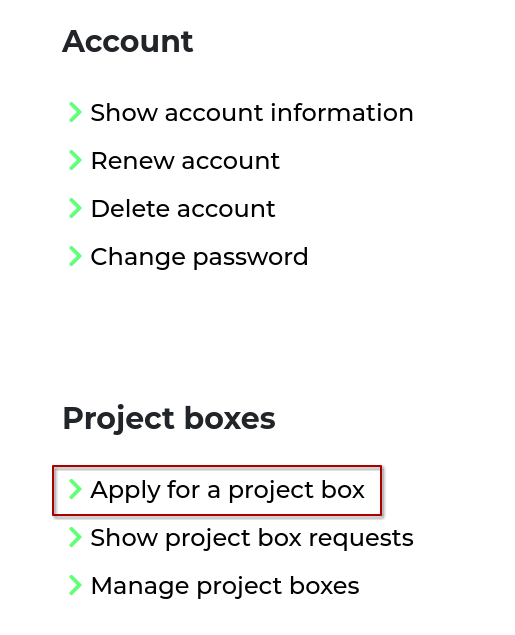
The form for the project box must be completed there; in the ‘Department/Workgroup’ field, please provide as precise
a description as possible of the actual working group. Also enter the e-mail address of a person who can be contacted if
you are unavailable in the “E-mail of Department/Workgroup” field. As the project box is not personalised, this makes it
easier to reassign the data when you leave the university and the project box becomes orphaned.
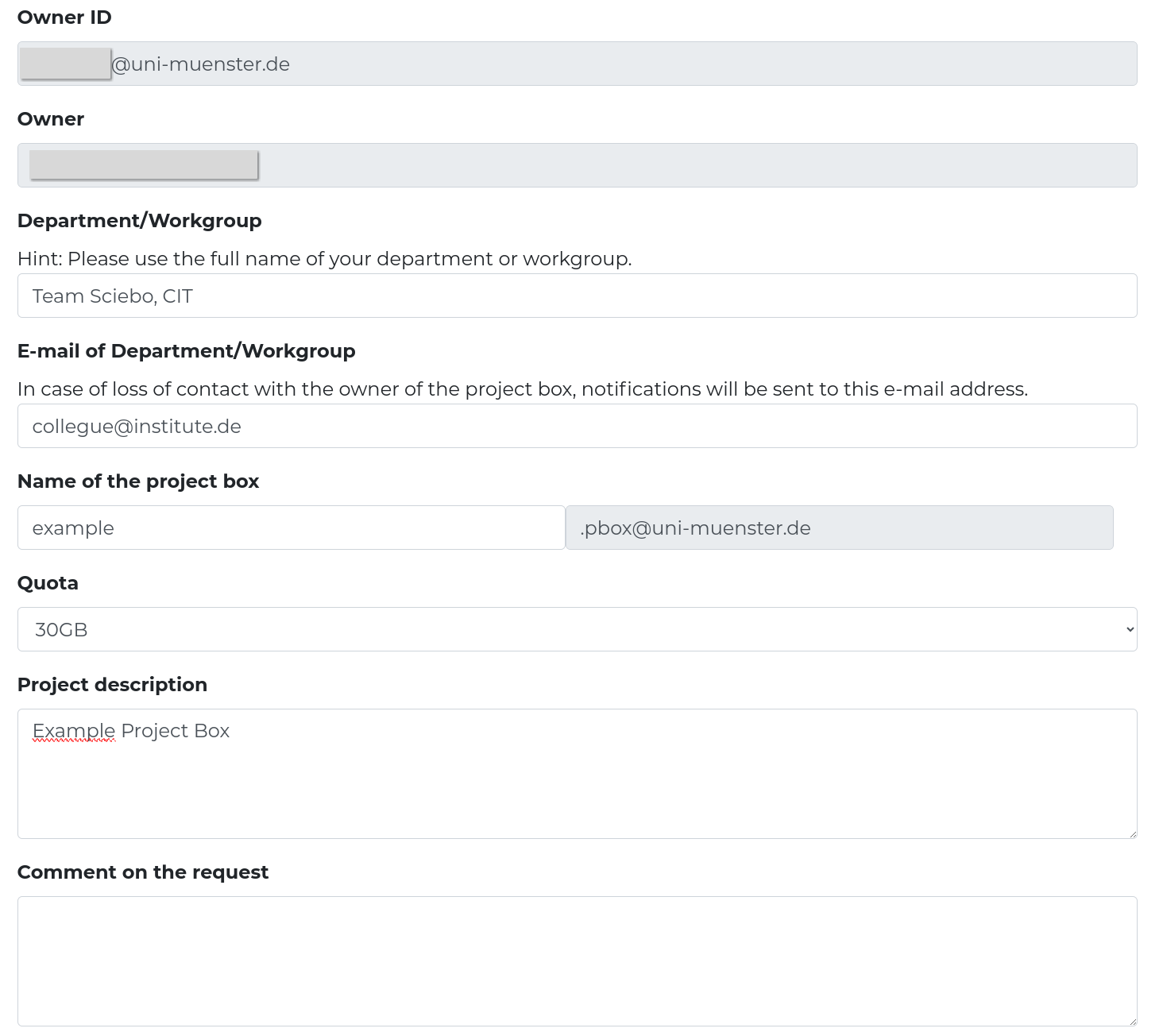
Set up a password
Once this request has been accepted, you can access the project box management menu in mysciebo by clicking on
‘Manage project boxes’:
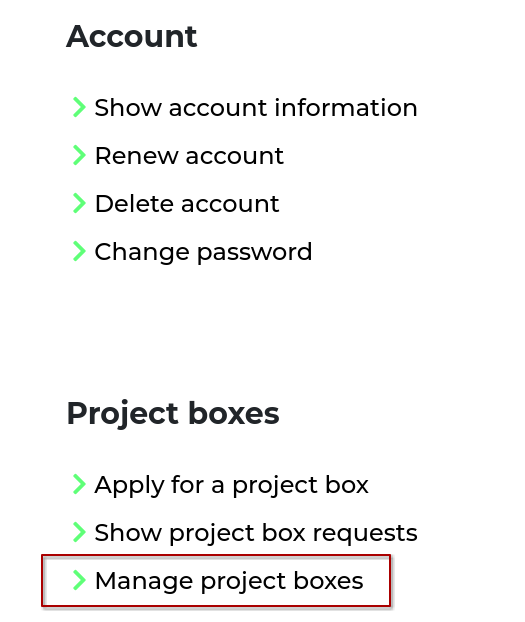
Here you need to set a password for the project box.

Log in to the project box and set up shares
Now you can log in to your own Sciebo instance with this project box. For me, this is
https://uni-muenster.sciebo.de. Please note
the .pbox@institute at the end of the project box name, for example .pbox@uni-muenster.de for the University of Münster.

You can now set up a folder structure in the project box; it usually suffices to just have a folder, which you share with
your personal Sciebo account:
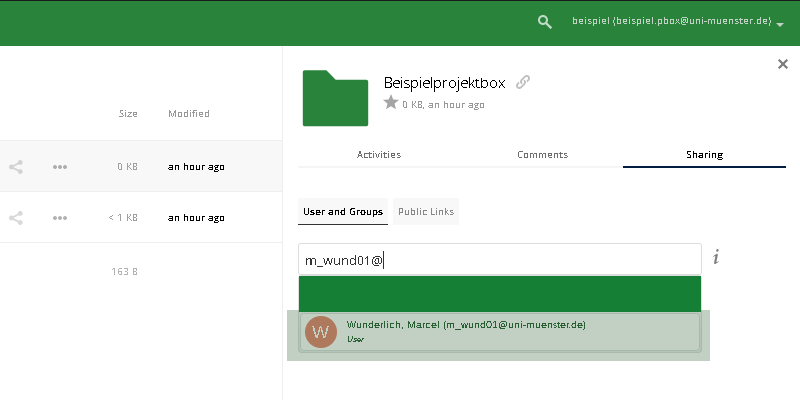
You can set the permissions by clicking on the cogwheel next to the share. By default, everything is allowed; this makes
sense for your personal account, as it enables you to share this project box folder with other project partners without
having to log into the project box again.

9.2 - Cryptnc
End-to-end encryption enables sensitive data to be transferred via the cloud without an administrator or third party being able to view the contents of the files on the server. Encryption and decryption is carried out by a client on the end device (computer, cell phone, tablet). The advantage of Nextcloud end-to-end encryption (E2EE) is that one can also share the encrypted folders without having to share the own key.
Prerequisite: an E2EE app must be activated on the server, original Nextcloud client version 3+.
Client configuration
Server address: https://cryptnc.uni-muenster.de
Credentials: standard university login and password.
Check that the option “This account supports end-to-end encryption” is displayed in your client. Click on “Set-up encryption” to generate the encryption mnemonic.

Please save this phrase as you will need it to decrypt the files on other endpoints or to recover the files if the device is lost.

If you have already enabled encryption on the client, you can look up the mnemonic phrase by clicking ‘Show mnemonic’.
Creating the ecrypted folder
Notice: Keep a second copy of the files on your computer outside the nextcloud folder, this should also be where you edit the files.
Use the encrypted folders to transfer files between different computers.
Try not to edit files inside the encrypted folder, as they may be irreversibly encrypted. There are methods to decrypt the files using the script provided by Nextcloud, but this method has not been tested yet, so we would rather advise you to do everything possible to avoid this risk.
Create the new folder. The folder must be empty to enable encryption. This is to prevent data loss. Any files placed in this folder will automatically be encrypted. The contents of this folder won’t be displayed in the web interface. On the server side, only the top level of files would be displayed in encrypted form. This way the admin won’t be able to see the data type. So, for example, if you put another folder in the encrypted folder, it would only be shown as a file, without any details about the files in it.
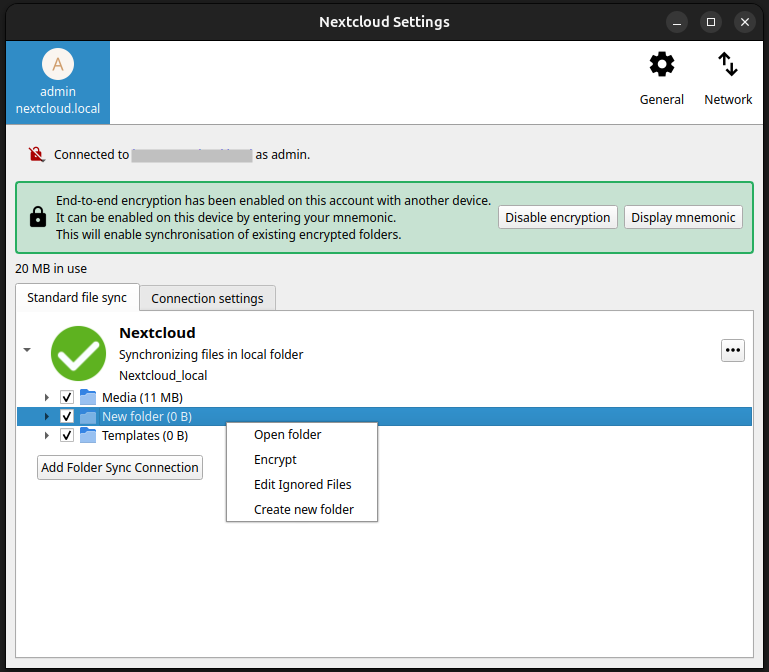
Sharing the ecrypted folder via Desktop Client
Activate the Nextcloud client and navigate to the Nextcloud folder on your computer.
Right-click on the folder you want to share. If the Nextcloud client is active, you should see Nextcloud in the menu.
Clicking on Nextcloud > Share options will open a window where you can add or remove shares for the chosen file or folder.
10 - Nextcloud Migration
Instead of ownCloud we are now using Nextcloud. What has changed?
In the coming weeks, Sciebo will gradually migrate all instances of ownCloud to Nextcloud. Nothing will change in the basic functionality, only a few features will be added.
In fact, everything should continue to work as before.
If not, this document will hopefully help.
If you’re having a more complicated case, feel free to email us as usual using our contact form.
Changes
- Apps are now at the top of the page and no longer at the top left of the menu
- Groups are now called Teams and can be found in the Contact app
- .odt, .odp. and other Libreoffice formats are no longer opened in Onlyoffice,
but opened in Collabora
- there are now a few new apps: Calendar,
Contacts, Deck (Kanban Board), Forms (surveys) and Polls (polls)
- The eye-friendly dark mode is activated by default; the menu at the top right
Light Mode as well as High Contrast and Dyslexia modes can also be set via the
modes
- Login only with Sciebo ID: Due to a bug, it was previously possible to log in with your e-mail address. Please only use
your Sciebo ID to log in. If in doubt, you can find out what this is in MySciebo
- Incoming shares can be automatically sorted into a separate folder. This can be selected under Settings/Share.
Help, my client is not working anymore
We recommend every user to uninstall the old sciebo client and install the new Nextcloud based after the migration.
Nevertheless, the old client is still working for the moment. The settings of the old client will be kept.
See: Nextcloud clients
Alternatively, the unbranded Nextcloud client can be used for each platform, especially for mobile devices. A Nextcloud
client for mobile devices can be found in the respective app stores (Play, FDroid and App Store).
Known issues:
For compatibility reasons, the Nextcloud client does not synchronize files containing characters reserved by Windows
in their name (“?”, “*”, “<”, “>”, “|”, “/”, “\” and “:”).
Migration Guide
-
Make sure that any synchronization currently running in the previously used sciebo ownCloud client has been completed.
-
Open the previously installed sciebo ownCloud client and click on “User Account.” Now select the “Remove” option. Confirm the removal of the account. No data will be lost.
-
Now close the sciebo ownCloud client.
-
Uninstall the sciebo client you have been using from your system.
-
IMPORTANT: Treat the sciebo folder on your hard drive as a backup and rename it, e.g., to backup_sciebo.
-
Download the sciebo Nextcloud client for your operating system from the following page: https://hochschulcloud.nrw/de/download/index.html We recommend using a client without VFS.
-
Install the client. If a system restart is required, perform it.
-
Set up the new client by first selecting your instance. In the browser window, you will be asked to authorize with your sciebo ID.
-
Set up synchronization according to your preferences. Do NOT select the sciebo folder previously used on your hard drive. If you have selected this folder and receive an error message, go back to step 5 of these instructions.
-
Complete the setup wizard and leave the PC on until synchronization is complete. Do not disconnect the device from the Internet during this time.
For advanced users
You can synchronize data from the old Sciebo folder to the new folder using ROBOCOPY or rsync -av (depending on your operating system). These command line tools prevent newer data on the server from being overwritten by any older data on the client.
11 - Sharing
TSharing is an integral part of sciebo. Learn how to share files with your peers.
Instructions
- click the sharing symbol next to the folder that you intend to share:

-
Enter the search term into the text field that has appeared:
IMPORTANT:
If the user that you are trying to share with is not part of your institution the search term has to have the following format: SCIEBO_USERNAME@institution.sciebo.de.
Else the sciebo-username is sufficient. The sciebo-username already looks like an e-mail, for example
mmustermann@uni-muenster.de. Thus to find Max Mustermann, who studies at the University of Münster, the following search term has to be entered:
mmustermann@uni-muenster.de@uni-muenster.sciebo.de.
If the Person that you are looking for is part of the same institution as yourself, the searchterm can be a lot less complicated, for example you can usually find such a person with the search-term family name, first name.
-
Select the user from the list
If the user does not appear during the search:
Because there are a lot of users in a lot of institutions, the autocompletion-function of the search-bar sometimes does not work well. Because of this it may happen that a user does not appear during a search. To solve this problem, write the search-term (for example mmustermann@uni-muenster.de@uni-muenster.sciebo.de) in a text-file, and copy-paste it into the search-bar.
Another reason that the person does not appear might be that the person that you are trying to find is not yet registered to sciebo - the user must have logged into sciebo at least once.
11.1 - File Drops
Receive very large files from people who are not members of sciebo.
If you want to receive data from externals that is too big to be received by
email, you can create a so-called file drop. You just have to create a public
share and choose “Download / View / Upload” or “Download / View / Upload /
Edit” as permission. Choose “Upload only (File Drop)” if users shouldn’t be
allowed to see the content of the directory.
For internal use, a normal share between users can also be used and might be
more appropriate.
To do this, create a folder, e.g. “filedrop”.
In the context menue on the right side, under the tab “Sharing” you can now
create a public link:
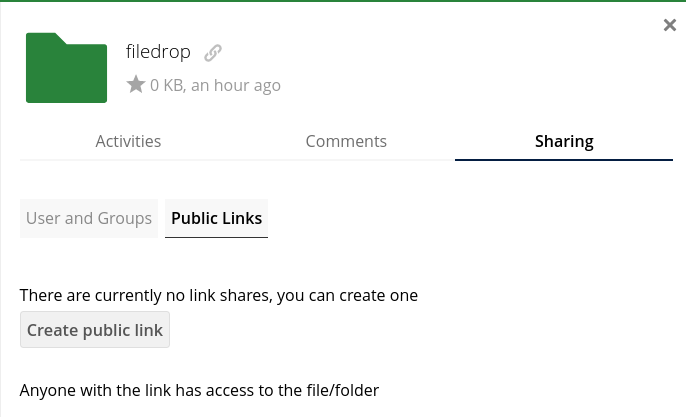
Here you can set the permissions, and also a password and expiry date.
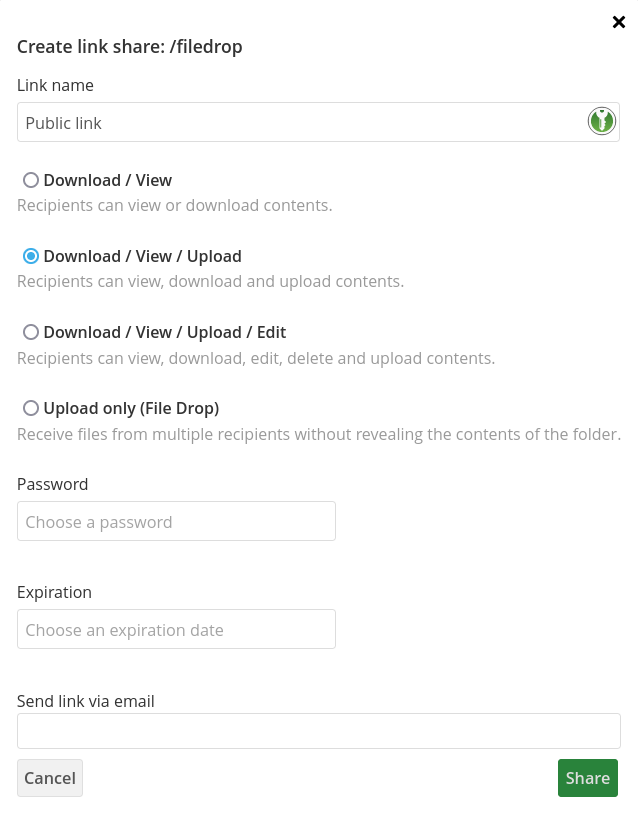
The expiry date is soft, i.e. the share does not vanish at 00:00, but it
usually takes a few hours until it is cleaned up.
11.2 - Groups
With sciebo you can create groups of users that you can share and edit files with.

If you often share data with the same group of people, you can create a group for this in the web interface. You no longer have to share data with each person individually, but can simply select the group you have created. All members of the group automatically get access to the data. You can set the editing rights as usual when sharing. Note, however, that groups can only consist of members of your own participant institution.
Creating Groups
- Log in to the sciebo web interface.
- Click on your name in the upper menu bar and then on “Settings”.
- Select “Custom Groups”.
- Enter a new group name in the text field and click on “Create group”.
- The member menu opens on the right.
- In the text field, enter the name of a person you want to add to the group, following the principle “last name, first name”. Select the person from the list that appears. He or she is now added to the group. Repeat the process for all other persons.
Managing Groups
To manage your groups, you must log in to the web interface. Click on your name in the top menu bar, then on “Settings” and select “Custom groups”.
Renaming a Group
- Move the mouse over the desired group. Click on the pencil symbol that appears next to its name.
- Change the name and confirm the change by pressing “Enter”.
Removing a Group
- Move the mouse over the desired group. Click on the bin symbol that appears.
- Click on “Yes” in the pop-up window to confirm the deletion.
Managing Group Members
To manage the members of one of your groups, you must log in to the web interface. Click on your name in the top menu bar, then on “Settings” and select “Custom groups”.
Adding Group Members
- Click on the group to which you want to add members. The members menu opens on the right.
- In the text field, enter the name of a person you want to add to the group, following the principle “last name, first name”. Select the person from the list that appears. He or she is now added to the group.
Please be aware that currently only users from the same instance can be added to a group.
Changing Group Roles
Group members can be either “group owner” or “member”. Group owners have all editing options for the group (including deleting, renaming, adding/removing members). There can be more than one owner. Members, on the other hand, cannot make any changes to the group. By default, only the person who created the group is the group owner. If you want to change the roles, proceed as follows:
- Click on the group whose member roles you want to change. The members menu opens on the right.
- In the list of group members you can see which member has which role.
- Move the mouse over the desired person. Click on the pencil symbol to change the role. (If you want to give up your role as group owner, you must confirm this, as you can no longer make any changes once you have given up the role).
Removing Group Members
- Click on the group from which you want to remove members. The members menu opens on the right.
- Move the mouse over the desired person. Click on the bin icon that now appears.
- Click on “Yes” in the pop-up window to confirm the deletion.
Sharing with a Group
In principle, you can share with a group in the same way as with individual users. Follow the appropriate instructions depending on the platform (web interface, client or app) via which you want to share. You only need to note the following differences:
- Instead of the person’s name, enter the group name when sharing.
- You can only set editing rights for the group as a whole and not for individual group members.
11.3 - Link Generator
Learn to share files and how to create shareable links. Regrettably, the link generator is not working at the moment.
When you share a folder or a folder is shared with you, that contains a lot
of subfolders, it is often annoying to navigate through the entire structure
or to explain to others how to get to a specific file. You can create a link that
leads to a specific folder that has been shared. This only works if the folder that
you shared is located in your root directory!
The link has the following form:
https://<institution of the person that you are sharing with>.sciebo.de/?dir=/<Path>/<to>/<the>/<directory>/
You can use the following tool to generate a link to a shared directory.
Share Link:
- In your browser, navigate to the directory that you want to share a link to.
- Copy the link from the address line of your browser into the field “File-URL”.
- Click “Apply”.
- Share the link to this page. The inputs you have provided will be persistent.
Follow Link:
You have received a link to this page.
- In the dropdown menu “Your Institution” select your institution.
- You can now follow the link in the field “Link to the File”.
Link Generator
File-URL
In the browser navigate to the folder that you want to share.
Copy the link from the adress line of the browser into this
field and click apply.
:
Link to this Page
This link leads to this link generator. Share this link with a person
that does not belong to your institution.
:
11.4 - Project Boxes
Project boxes are specialized sciebo accounts for work-groups that work with large amounds of data (30 GB to 2 TB).

Project boxes are special sciebo accounts for work groups that work with very large amounts of data (30 GB to 2 TB). They are particularly suitable for long-term projects with changing project management. Project boxes are not bound to individual persons, i.e. the role of the owner is transferable. Project boxes are managed in the owner’s my.sciebo section.
Click here for “HOW TO: Create and Manage Project Boxes”
Availability and Application Procedure
The institutions listed below provide project boxes. Unless otherwise noted, all employees with a sciebo account can apply for one.
Application via my.sciebo
- Deutsche Hochschule der Polizei
- Fernuni Hagen
- FH Dortmund
- FH Münster
- Folgwang-Uni Essen
- hbz NRW
- HS Bielefeld
- HS Bochum (professors only)
- HS für Gesundheit
- HS für Tanz und Musik Köln
- HS Hamm-Lippstadt
- HS Rhein-Waal
- Kunstakademie Düsseldorf
- Kunstakademie Münster
- Ruhr-Universität Bochum
- RWTH Aachen
- TH Köln
- TH Georg Agricola Bochum
- TU Dortmund
- Uni Bonn
- Uni Düsseldorf
- Uni Köln
- Uni Münster
- Uni Paderborn
- Uni Siegen
- Uni Wuppertal
Application to the IT Centre
- FZ Jülich: e-mail to IT representative/administrators
- RWTH Aachen: e-mail to IT orderers
- Uni Bielefeld: e-mail to service desk
Special Form
Application
The application should contain the following information:
- Applicant
- Project box name/identifier: 4 to 32 characters; e.g. Project-XY with the identifier project-xy.pbox@Your-Institution.de"
- Department/Organisational Unit
- Project description: In addition to a project title and a short abstract, information on the responsible organisational unit, project duration, project participants or funding may be useful. The text must not exceed 150 words.
- Storage volume: 30, 500, 1,000 or 2,000 GB
For all applications, the support of the institution decides on an approval. Once the application has been approved, you will be notified by e-mail.
Activation
In order to use the project box, you must first set the password:
- Log in to my.sciebo with your central user ID (not sciebo ID).
- Select the menu item “change project box password”.
- Select the desired project box from the drop-down list.
- Enter the new password.
- Log in to the sciebo web interface of your institution with the project box ID to activate the project box.
Usage
Direct access to the project box is only necessary for assigning access rights to the central project folder (using shares) and managing the associated editing rights:
- Log in to the sciebo web interface of your institution with the login data of the project box.
- Create a central project folder to be used for the project data.
- Share this folder with your own personal sciebo ID and the other project participants.
- You and the project participants can now access the shared project box folder via your/their own sciebo account(s) and create and edit folders and documents there.
Extension and Transfer
- Extension: The duration of a project box is 2 years. An extension is possible via my.sciebo.
- Transfer: The transfer of a project box is initiated via my.sciebo. (*Note: In order to enable the transfer to another person, no personal or copyright-protected data may be stored by the participants).
12 - Sicherheitseinstellungen
These safety settings should be made
In the web interface, you can make additional settings to protect access to your sciebo account.
2-Factor Authentication
Two-factor authentication is a feature that increases security when accessing the sciebo web interface. When logging in, you must enter a 6-digit number in addition to the sciebo password, which you receive anew for each login via a 2-factor app.
- Before you can activate 2-factor authentication in sciebo, you need to download a 2-factor app for your mobile device (e.g. FreeOTP, Google Authenticator).
- Then log in to the sciebo web interface.
- Click on your name in the top menu bar, then on “Settings” and then on “Security”.
- Check the box to activate 2-factor authentication.
- A QR code will be displayed. Scan the code with your 2-factor app. (Alternatively, you can enter the displayed numerical code manually).
- Now enter the latest sequence of digits from the 2-factor app in the field provided and click on “Check”.
- If “Verified” is displayed, the function is activated. (If you enter the code too slowly or confirm too late, you must repeat this step with the next sequence of digits).
Notes:
- If you want to use different mobile devices for 2-factor authentication, scan the QR code directly with all devices as it will not be displayed later for security reasons.
- If you want to delete the 2-factor app from your mobile device, you must first deactivate 2-factor authentication in sciebo. Otherwise, you will no longer have access to the sciebo web interface.
App Passwords
App passwords are 16-digit security codes that allow a device to access your sciebo account. They are valid only once and are entered instead of the sciebo password when logging in. The use of app passwords is only useful in exceptional cases, for example if the sciebo password would be stored in plain text on your end device.
- Log in to the sciebo web interface.
- Click on your name in the top menu bar, then on “Settings” and then on “Security”.
- Enter a name in the “App name” field and click on “Create new app passcode”.
- The app password is now displayed once. Use it to log in to sciebo in the desired app or on the desired device.
- Click on “Done” to complete the process.
13 - Starcloud
Information for the support team.
13.1 - AAI
We have not yet translated this page. Click here for the german documentation.
























